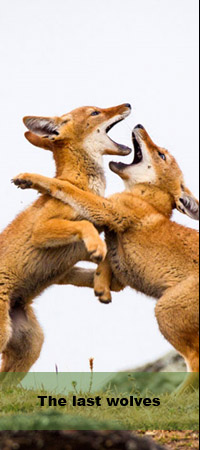Did you know about the Ethiopian wolves?
Less than 500 Ethiopian wolves (Canis simensis) exist in the wild. They are threatened by diseases transmitted by domestic dogs, habitat loss, and hunting. The Ethiopian wolf is endemic to the Afroalpine highlands of Ethiopia. It inhabits elevations of 3,000 to 4,500 meters (10,000 to 15,000 feet) where conditions are harsh but beautiful. Burrowing rodents are some of the most abundant wildlife on the highlands where wolves remain. The Ethiopian wolf feds almost exclusively on rodent (grass rats and mole-rats) year-round, many of which are endemic the Ethiopian highlands. It plays an important role in rodent control, with their greater efficiency at capturing live rodents in farmland habitats.
Although they are solitary hunters, Ethiopian wolves live in discrete and close-knit social packs that communally share and defend an exclusive territory. In optimal habitat packs consist of 3-13 adults, containing 3-8 related adult males, 1-3 adult females, 1-6 yearlings, and 1-6 pups. Half of the world population lives in the Bale Mountains of southern Ethiopia. Outside Bale, the existence of six other isolated populations have been observed during past and recent field surveys. Isolated populations do not surpass 50 individuals with a constant high risk of extirpation. Two population extirpations have been documented, and habitat destruction to agriculture largely explained local extinctions in small vulnerable habitat patches. While the Bale Mountains are crucial for the long-term persistence of this canid, small populations are also crucial for the survival of the species. The loss of only a small number of individuals in, or even short-term unsuccessful breeding attempts, may have disastrous effects on survival of the Ethiopian wolf.
The peaceful coexistence between people and the rare Ethiopian wolf is being challenged by conflicts rising due to livestock predation by wild carnivores. In the case of the rare and endangered Ethiopian wolf, even low levels of retaliation could send populations into an extinction vortex, given their small size and additional threats from viral diseases, habitat loss and degradation. Persecution of wolves in the region, due to the concern over predation of livestock, is significant threat to some of the remaining populations, and has likely been the cause of decline in some areas where wolves have recently disappeared.

Photos: Habitat of the endangered Ethiopian wolf in Afroalpine highlands of Ethiopia. Photographs by REDA&CO and Jean-Claude Latombe.
Awareness campaigns
Literacy was linked to positive attitudes towards Ethiopian wolves in Aboi Gara, possibly indicating tolerance developed through education and better knowledge of livestock husbandry practices. Awareness campaigns and education have helped to foster coexistence with carnivores in many cases and this approach is an important part to save the rarest canid.
Keeping small herds and supporting the presence of shepherds
In general, households with larger herds experienced more livestock attacks and were also prone to enter conflict with wolves. Similar results have been reported from around Annapurna in Nepal, where larger herds were more vulnerable to predation by snow leopards (Unicia unicia), because shepherds guarding them for extended periods have to disperse more widely over the available grazing land.
Maintaining shepherds close to the herds at all times, and minimizing the time spent in Afroalpine areas could contribute to stop conflicts from escalating. Studies across African carnivores have shown that when shepherds were present, rates of predation were much lower. This is a simple, effective, affordable and low technology solution that should be promoted among pastoralists communities in Ethiopia and would increase significantly the protection of the Ethiopian wolf.
Local communities are key to their survival
Ethiopian wolves and the communities living next to them compete directly for natural resources upon which both depend. The people of the highlands engage in subsistence agriculture and livestock rearing, relying on natural Afroalpine habitats for pastures, firewood and building materials. With rapidly increasing human populations in the highlands, habitat loss and degradation are impacting upon the populations of rodent prey, challenging the wolves to adapt to an anthropogenic landscape. Working hand in hand with human communities in the highlands is the most important field strategy to save the Ethiopian wolf and recover its populations in the wild.
Related links
Endangered Species International is a U.S.-based, international organization, and a nonprofit, tax-exempt corporation under Section 501(c)(3) of the U.S. Internal Revenue Code. Your donations are tax deductible under U.S. laws.
|











